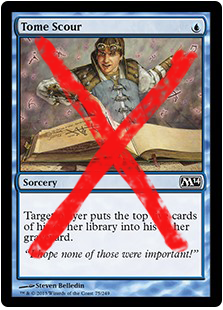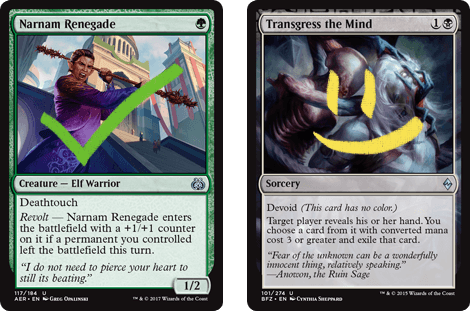The Miserable Mill
Dear reader,
I implore you, return to the previous page.
Please, push that snake-shaped back button in your browser's window, and snap back to the front of this website. I am confident there is some more joyous article featuring new cards or flavorful endeavors that shall lift your spirits. DailyMTG is full of such wonderful articles.
If you are to continue traversing this saddening story, it is my solemn duty to inform you that the side effects may include deciding to reconstruct your favorite decks; having parts of Magic you once frivolously enjoyed crushed like a beetle under a large boot; and, finally, some would argue the most treacherous side effect of all: learning.
I would understand if any or all of you left right now after this truly bad beginning. Do not feel compelled to stay at my behest. It is my job to report the facts as they are, but it should be no one's job to be forced to listen.
However, for those brave enough to stick it out and remain in this austere academy, please read onward.
Into the Mill
How strong is this card?
Tome Scour mills five cards. "Mill" is a colloquial term that originates from the card Millstone, used here to mean "putting the top cards of a player's library into his or her graveyard."
For example, you could say, "In the finals of the Pro Tour Qualifier, Herbert cast Tome Scour to mill away my final five cards, dashing my chances of playing on the Pro Tour."
There are many players who will play with Tome Scour in their decks. And, to their credit, it is not always incorrect to do so.
Rather, it is only incorrect a very large percentage of the time to do so.
You should usually not be playing with Tome Scour. And that is because milling, in and of itself, is not a productive thing to do.

I am sure there are some surprised faces among readers. Many of you may love milling an inordinate amount, and, as mentioned in the warnings above, there is the dangerous possibility of having to change your decks after reading this article. No judgment will be passed on those who back out now.
However, for those few who wish to press on, let me explain.
Milling sounds attractive because you get to "destroy" many of your opponent’s cards at once.
When you cast a Tome Scour and put your opponent's Torrential Gearhulk and Disallow into their graveyard, it feels like you have taken those away from your opponent. You've locked those cards away in some ersatz elevator, preventing them from getting out. And as we all know, nothing ever skitters out from a locked elevator.
However, there are three big reasons that isn't quite true. Let's go over them here.
1. You Haven't Impacted the Board
In Magic, every action you take should generally meaningfully impact the hand or battlefield in some fashion.
Playing a creature, I'm happy to report, grows your ability to attack and win the game. Making your opponent discard cards, I'm also happy to report, reduces their available options and helps you win the game. These options get sunny checkmarks and those ever-popular smiley faces you see used in text messages.

Less happily, milling does not generally impact the game. If you play a Tome Scour, you are casting a zero-for-one.
The "number-for-number" construction is used in Magic to indicate that you are spending some number of cards to obtain another number of cards-worth of value.
For example, if you cast a Glimmer of Genius, that's a two-for-one. If you are fortunate enough to cast a Fumigate on a board with thirteen of your opponent's creatures, that's a thirteen-for-one. Those are both great results.
A one-for-zero, however, means you are spending one of your cards to deal with zero of theirs. This is certainly not generally considered a great result.
While it may look like you dealt with five cards using Tome Scour, as is often all too cruelly the case in life, looks can be deceiving.
While you took those cards out of your opponent's deck, you didn't actually diminish their available resources. Nothing has changed from what your opponent has access to in their hand or on the battlefield.
Unless you predict the game is going to reach its conclusion by running your opponent out of cards, those cards could have just as easily been on the bottom of your opponent's library and the result would have been the same.
You probably wouldn't play a card that just put the top five cards of your opponent's library on the bottom of their library—and that's equivalently what pure milling often is.
2. You Can't Control What You Mill
There can be very specific times where taking cards out of your opponent's library crumbles their strategy.
Using a card like Lost Legacy to chew up your opponent's crucial cards like lions or clowns at a carnivorous carnival can be a complete cannonball if cast at the correct moment. (Though they're still something to be played with caution.)
However, the strength in a card like Lost Legacy is that you can choose what you take out. Though you are often taking a zero-for-one to do so, removing all your opponent's combo pieces can be worth it.
If milling was the same, I could sit here and happily report to you that milling was indeed worth it on occasions. That casting a Tome Scour and removing all chance of your opponent winning was a strategic endeavor commonly employed by professional players around the globe.
However, that is not the case. And as such, it is my unfortunate job as an informant to report that milling does not have the same targeted effects.

When you mill your opponent, there's no real guarantee what you're going to hit. Like hearing a shrouded snake slither around a reptile room, there's no telling if it is going to be a harmless garden snake or an extremely deadly rattlesnake that will bite your good friend Beatrice. It could just as easily be five lands as all five of their Gearhulks. It is impossible to tell at the time of casting.
However, completely unlike rattlesnake venom, which research and experience shows is entirely lethal to humans in untreated cases, even when milling hits your opponent's best cards it may not end up mattering. (See the first point for more on this.)
This means that not only are you not always going to hit anything good, when you do it might not even matter.
Or worse yet . . . Well, let's get into point number three, shall we?
3. The Graveyard Isn't Gone
In perhaps the ghastliest turn of events yet, milling your opponent may actually just be helping them. Yes, that's right: your sinister plot to deplete their best cards just dropped them into a hostile hospital, waiting to happily be rehabilitated.
In the world of today's Magic, there are so many ways to return something from the graveyard or gain benefits from it being there. Going back the original example many paragraphs ago, let's look at the two cards you milled away:
Milling the Gearhulk, if they are playing a Constructed deck, is likely an indicator they have even more Gearhulks. And if you put that Disallow there, it means they can use a future Gearhulk to cast it without any trouble at all! You have aided your opponent.
And that's just a penultimate peril compared to what could happen. Imagine playing mill against a deck focused on delirium!
Milling your opponent can be playing right into their deck's game plan. Even in Limited, it is incredibly dangerous to do given common effects that return cards from graveyards to their owner's hand.
A Lighthouse in the Dark
Now, there is a bright glimmer of hope in this murky, leech-ridden lake of despair. Though I have provided many warnings, if you keep those in mind, there are three primary instances where milling can be correct to pursue. Arm yourself with your array of knowledge so far and follow me with trepidation.
1. If Your Deck Is Built Around Milling
In a dedicated mill deck, milling is, of course, appropriate. Saying otherwise would be a lot like saying to not put milk in your cereal or to not spray badger repellent onto your swamp boots.
As a subcategory of this, there are some times where incidental milling can power up your other cards. For example, Wight of Precinct Six and Jace's Phantasm. If your deck is focused on this, some amount of milling to power them up can also be reasonable.
If your plan is to legitimately use milling in one of these ways, go for it. A word of caution, however: historically, milling has not been a strong competitive strategy.
That's not to say that it never has, or that it never will, or that you shouldn't use it. But just be careful and playtest plenty if this is something you are looking at for a large tournament. Mill doesn't affect the board, which means that it's very hard for your cards to do anything else if your primary strategy doesn't work out.
2. You Are Milling Yourself
Yes, that's right: a truly terrible twist. Remember earlier when we discussed the many perils of milling your opponent? Well, sometimes you want to mill yourself for the same reasons that it is dangerous to mill your opponents. Putting cards into the grim grotto of your graveyard can be beneficial!
If you are playing a deck built around something like delirium or dredge, you will want to mill yourself. (The Dredge deck archetype is based around the graveyard mechanic dredge, which is known to contain mostly incomprehensible nonsense.)
In the case where the graveyard is good for you, please embrace your grave with open arms. But not literally, of course.
3. When the Milling Is Incidental
Some cards will do something else and also mill. For example, look at Pilfered Plans. The primary effect you want here is the card draw, and it also mills a couple cards.
Having your plans pilfered is no pleasant experience, and my foggy recollection of the matter is that it does tend to mill away some memories.
In any case, with cards like these, as long as the primary effect is something you'll play on your own, then there's nothing wrong with playing a card like this. I would generally value the bonus milling at zero or perhaps even a slight negative if it risks helping out my opponent, however, so the base effect must really be strong enough.
The End
Regrettably, you have now read all the information contained in this article. If you are not driven mad by its echoes, I hope you will use it to guide your own Magic performance going forward and mill only when appropriate.
If you have any inquiries, questions, complaints, or tales of terror or otherwise, they are always most welcome. You can reach me in my vile village on Twitter, Tumblr, or by sending an email (in English, please) to BeyondBasicsMagic@gmail.com.
I will return with another tale next week. Until then, it is my sincere hope that you go read something nice and full of sunshine that makes the world seem lighter and more wonderful than the vast doldrums listed in this awful article. Best wishes on your quest.
Sincerely yours,

